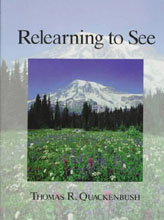In this ground-breaking presentation of the Mates method, Thomas R. Quackenbush describes how eyesight can improve naturally - at any age and regardless of heredity. With this simplified, practical, self-help approach to improving eyesight you can relearn to see - naturally and clearly, without glasses or surgery.
Lavishly illustrated with more than sixty color plates and one hundred and fity images, including Distance and Near Eye charts, Relearning to see, is a virtual encylopedia of natural eyesight improvement. In this indespensable book you will learn:
*) How thousands of adults and children have improved or eliminated their nearsightedness, farsightedness, presbyopia, astigmatism, crossed eye, lazy eye and other vision problems.
*) Why relaxation of the mind and body and the release of subconscious tension are the keys to improving and preserving normal eyesight.
*) Why the Bates method is about relearing correct vision habits - and not about eye exercises.
*) How the crutches of eyeglasses and contact lenses can strain your eyes, mind and body, make your vision worse, and result in continually stronger prescriptions.
*) How to avoid eyestrain while reading, watching television, at work, using a computer, and under artificial lightning.
*) How clarity, blurred vision, and the Bates method can be understood with modern right-brain/left-brain concepts.
*) How to avoid moving into eyeglasses and contact lenses.
*) How headaches and neck pain have been relieved by natural eyesight reeducation.
*) Why refractive corneal surgeries (RK, laset, etc.). ortho-keratology, and other artifical forms of eyesight correction can be harmful and risky.
